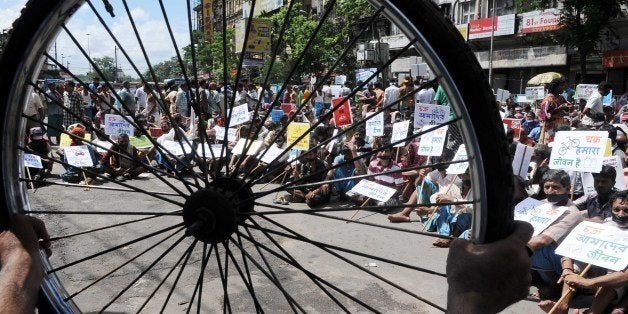
A few months ago Kolkata traffic authorities banned cycling on major thoroughfares. Over 170 main roads were affected (up from 38 initially), and this within the only major Indian city where daily bike trips -- 2.5 million of them -- outnumbered car trips. It is disheartening to see bicycles banned in a prominent metropolis like Kolkata, India. With this ban the city is pursuing a transportation policy that discounts flexibility and real improvement to the system. Instead this decision narrowly addresses transport issues at the expense of the health, safety, and quality of life of city residents.
The authorities intend to increase travel speeds through the city (for autos) as an important step in the modernization of Kolkata. They see this as a means to help the city achieve a robust information technology industry (IT) and attract new businesses. This approach, however, amounts to little more than rearranging the people and goods already on the road. It may work in the short term. However, as more and more trips shift from bikes to autos, all will require additional road space. And if this strategy succeeds in growing Kolkata's economy, that same transportation network will need to carry an increasing load of both people and goods. It won't be long until more road capacity will be required. Cities in the U.S. have been struggling to 'pave their way out of congestion' for decades. It doesn't work.
As an economic development strategy, it is hard to argue with placing the emphasis on transportation. International economic centers like New York City and London focus on increased and improved options for transportation. They encourage certain types of congestion, and of course manage automobile use. They most certainly do not, however, confuse the concept of traffic reduction with an increase in the number cars on the road. These are cities known for their public transportation and their recent forays into increased bike use (CitiBike), as well as zones that are designed to discourage individual auto use through taxation. They do not view the bicycle as an antiquated novelty. Rather, they see it as an important piece of the transportation network and as an amenity that attracts creative and industrious talent.
It has long been thought that more driving -- and indeed greater driving ease facilitated by abundant roadways -- goes hand-in-hand with economic growth. However, recent trends in the U.S. show that National Gross Domestic Product (GDP) continues to increase as individuals drive less each year. In the last decade, we've seen a 'decoupling' between the extent of driving and the growth of our economy. This trend has been observed in other developed countries as well. The relationship persists at the state level; states with higher car use have less per capita wealth.
This seems particularly relevant for the IT industry that Kolkata hopes to attract. According to the rankings of the League of American Bicyclists, the 25 states most supportive of biking have a per capita GDP about 13 percent higher than the other half. When we focus on just the IT-related economy even stronger relationships appear; the average IT economy in the top 25 biking states is more than 200 percent larger than that of the bottom half, and the top 10 biking states have, on average, 2.5 times the IT dollars per person than the other 40 states ($3,516 versus $1,359). It would appear that the more bike-friendly states in the U.S. have done a much better job of attracting skilled workers to the IT industry.
Kolkata's recent biking ban is also likely to add to the city's health costs. According to a recent report by the WHO International Agency for Research on Cancer, air pollution is a major cause of cancer, especially in Kolkata and Delhi. Further, the Indian Centre for Science and the Environment has noted that during the years 2009-2011, lung cancer was the leading form of carcinoma, with many cases occurring in non-smoking individuals. Half of India's urban dwellers live in cities that exceed particulate matter standards; a third live in areas whose air quality is classified as "critical."
Active commuting (via biking or walking) provides documented health and economic benefits. In the U.S., cities with the highest rates of biking and walking have rates of obesity and diabetes 20 and 23 percent lower, respectively, than cities with the lowest rates of active commuting. Our own research shows savings of approximately 1,300 lives and $8 billion annually in health and mortality costs in the Upper Midwest region alone. In London, bicycle commuting has been estimated to reduce heart attacks and stroke by almost 20 percent.
Given Kolkata's abundance of cyclists, encouraging biking would seem an ideal way to distinguish itself from Indian counterparts. It could simultaneously stake its claim for India's IT growth while making meaningful progress toward modernity. Such a path begins with policies that legitimize and respect forms of transportation that include cycling and walking. As popular and widely used as these modes are, it is hardly a surprise that Kolkata's recent miscalculations have been met with protest.
In the face of the IPCC's recently released 5th Assessment Report (AR5), urban policies like Kolkata's ban on cyclists are particularly unfortunate. The AR5 emphasized the increased likelihood of dangerous and widespread atmospheric warming by the end of the century, and Kolkata has chosen to pursue a misguided policy whose negative implications will affect global climate as well as the local health and economy.